Exploring a new side of an icon’s fight for justice and equality
Editor and writer Laura Tomaselli discusses her work on the award-winning documentary MLK/FBI.
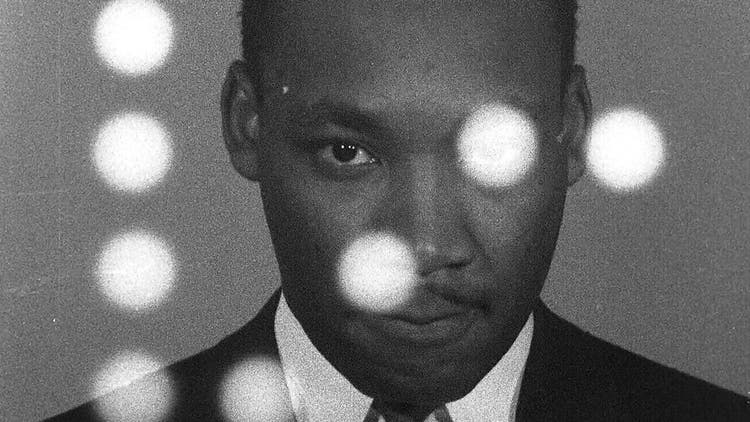
Image source: IFC Films.
The award-winning documentary MLK/FBI unveils newly discovered files from the FBI’s surveillance of Martin Luther King Jr. during the height of the Civil Rights Movement. Editor and writer Laura Tomaselli worked closely with director Sam Pollard to create a compelling examination of the history of oppression and social justice in America. With the visuals of the film being entirely created using archival footage, Laura trusted Premiere Pro to handle the many different formats of footage she was managing to compile an award-worthy story. Laura, currently nominated for a Cinema Eye Honors Award recognizing her work on the film, discusses her work below.
How and where did you first learn to edit?
I learned to edit in two parts — the first was in college. Even though my school didn’t have a proper film major, some alumni had decided to gift two editing suites which were unceremoniously carved out of the basement of an anthropology building. But even if I started editing then, I really learned to edit at my first job as an assistant/junior editor at a trailer house in New York.
The most obvious lesson was how to tell a dramatic story economically. The language of trailer editing teaches you all these techniques to push and pull emotions — adding tension, raising stakes, tugging at heartstrings. At the same time, you have to try to hone in on what makes the film feel unique.
A second lesson was the way I learned how to ‘break down’ or pull selects from a film. Trailer editing sort of forces you to decontextualize all these lines of dialogue and shots from a finished film to create a new structure and arc. It’s a really useful mindset in terms of being more experimental with what needs to be expository and what can be evocative.
How do you begin a project/set up your workspace?
A wise friend of mine once said that the success of every project was “a race against losing your enthusiasm for it.” In that spirit, whether it’s a short or long-form project, I try to organize in a way that feels tidy but doesn’t overly impede my ability to work quickly.
In the first leg of an edit, I try to split my time between completing a thorough prep of the project (selects, etc.), research, and sketching out any first impressions or ideas I’m excited about. I’ll also do a lot of music research early on, building a sort of mood board for the tone of whatever I’m working on even if we don’t use it. To me it’s about finding these little footholds, whether it’s a line or image or tone, that I can start building around.
Tell us about a favorite scene or moment from this project and why it stands out to you.
I have a lot of favorite moments sprinkled throughout but still really love the opening where we introduce Dr. King at the March on Washington. Here is this exemplary man, on the cusp of giving his iconic “I Have a Dream” speech, and we had all this beautifully shot and restored footage that just rendered that anticipation so vividly.
My first edit of the March on Washington section was nearly 10 minutes long and because our rough cut was strictly chronological, this scene happened somewhere in the middle of the film. Sam immediately knew that he wanted to try and open with it. He loved the idea of using A. Philip Randolph’s intro of Dr. King as a “moral leader” for the entry point into the film.
What were some specific post-production challenges you faced that were unique to your project? How did you go about solving them?
When you’re working on any archival project but especially one that draws from a more distant time period, you will encounter a veritable buffet of historical codecs and resolutions. They will not play well with each other. Very early on (and without an assistant editor), I knew that I needed to develop an automated system to manage this. A simple hack was to have Brian Becker, our brilliant archivist, upload each delivery to a directory that I’d marked as a watch folder with custom settings. That made it easy to ensure that all new footage was automatically transcoded to a proxy codec, resized to 1080, and ready to smoothly edit with.
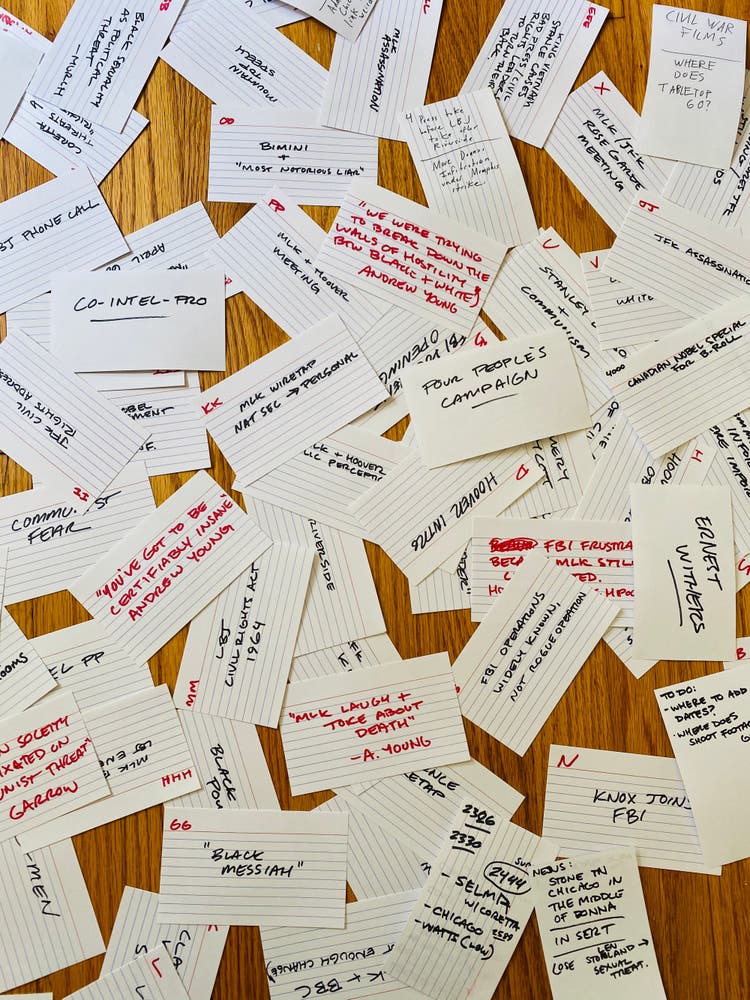
What Adobe tools did you use on this project and why did you originally choose them? Why were they the best choice for this project?
Between myself and the film’s other creative collaborators, we bounced around the full set of Creative Cloud apps quite a bit. Editing in Premiere Pro was a no-brainer because the interface is second nature to me at this point and I knew it would be able to accommodate whatever ways our workflow needed to evolve throughout the process.
What do you like about Premiere Pro and/or any of the other tools you used?
Beyond the above, one of the reasons I love Premiere Pro for this kind of editing is how quickly I am able to modify my workspaces to focus in and address something (a quick color correct on a shot, or audio cleanup) without losing the inertia of pushing the edit forward.
With MLK/FBI, using so much archival meant I was in a constant battle with cleaning up audio and picture that had been warped over time. Essential Sound was clutch in helping finesse a lot of audio in the offline edit that would have otherwise been incomprehensible.
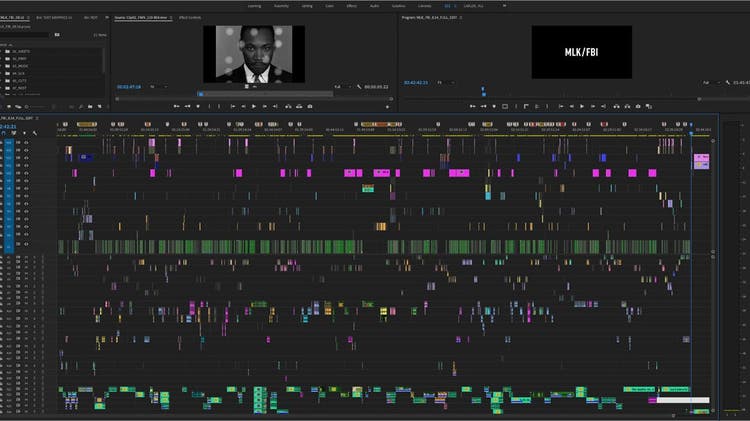
What’s your hidden gem/favorite workflow hack in Adobe Creative Cloud?
This is not a great technical brag but one of my workflow hacks involved Adobe Acrobat. Our film relied so much on these large redacted document dumps from the FBI — PDFs that could be anywhere from 200–900+ photocopied pages in random order. Acrobat was able to batch export these to .pngs that I could look through and directly edit with very quickly and simply.
Who is your creative inspiration and why?
It might sound trite but I really was inspired every day by watching Dr. King. I enthusiastically went through hours and hours of footage of him (an amount rivaled only by the FBI agents in their day). I spent a lot of time just weaving together these incredible clips of Dr. King speaking. Whether it was in a speech, sermon, or interview, his brilliance and poise as an orator is timeless. Editing this felt very much like a conversation with the present.
What’s the toughest thing you’ve had to face in your career and how did you overcome it? What advice do you have for aspiring filmmakers or content creators?
After graduating college, I was an aspiring cinematographer in Portland, Maine for exactly one month before I broke my leg in a pickup soccer game and had to move back in with my parents. Brutal. Hilariously enough, that led me to an internship in post-production close to home. While my career path after that is definitely not a straight line, I’ve always tried to be flexible, recalibrate, and make the best of things. Getting through 2020 was no different.
One of my favorite pieces of advice I took from the great editor Mary Lampson. She said that on every project she always edits with a post-it note visible that says “F**k Exposition.”
Share a photo of where you work. What’s your favorite thing about your workspace and why?
I love a big empty desk but I always try to change locations whenever I’m stuck.
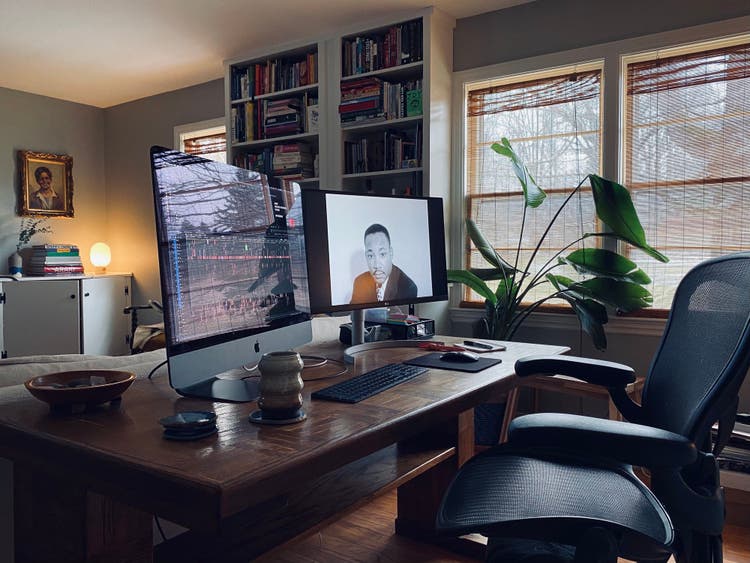
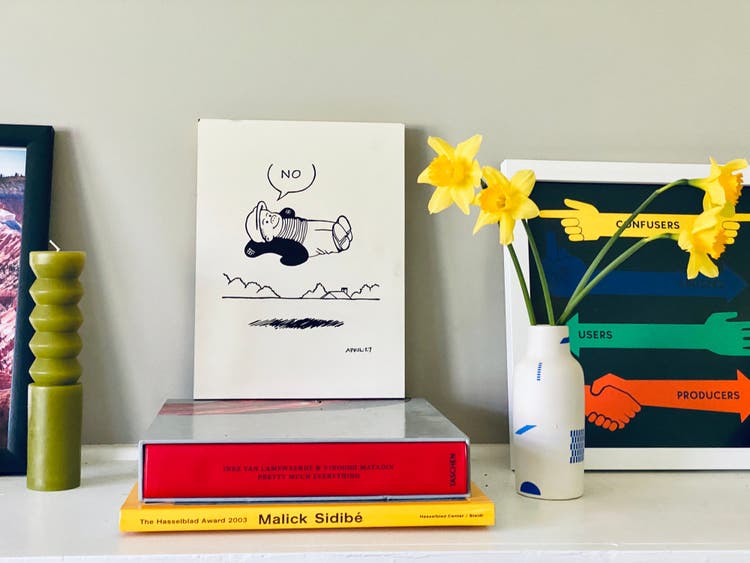
MLK/FBI is available in theaters or to stream at home.